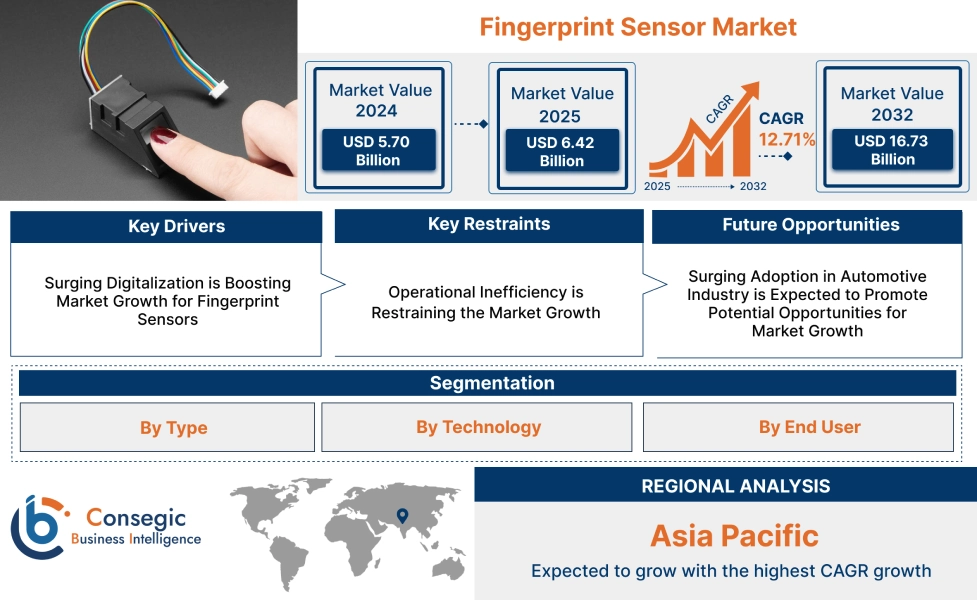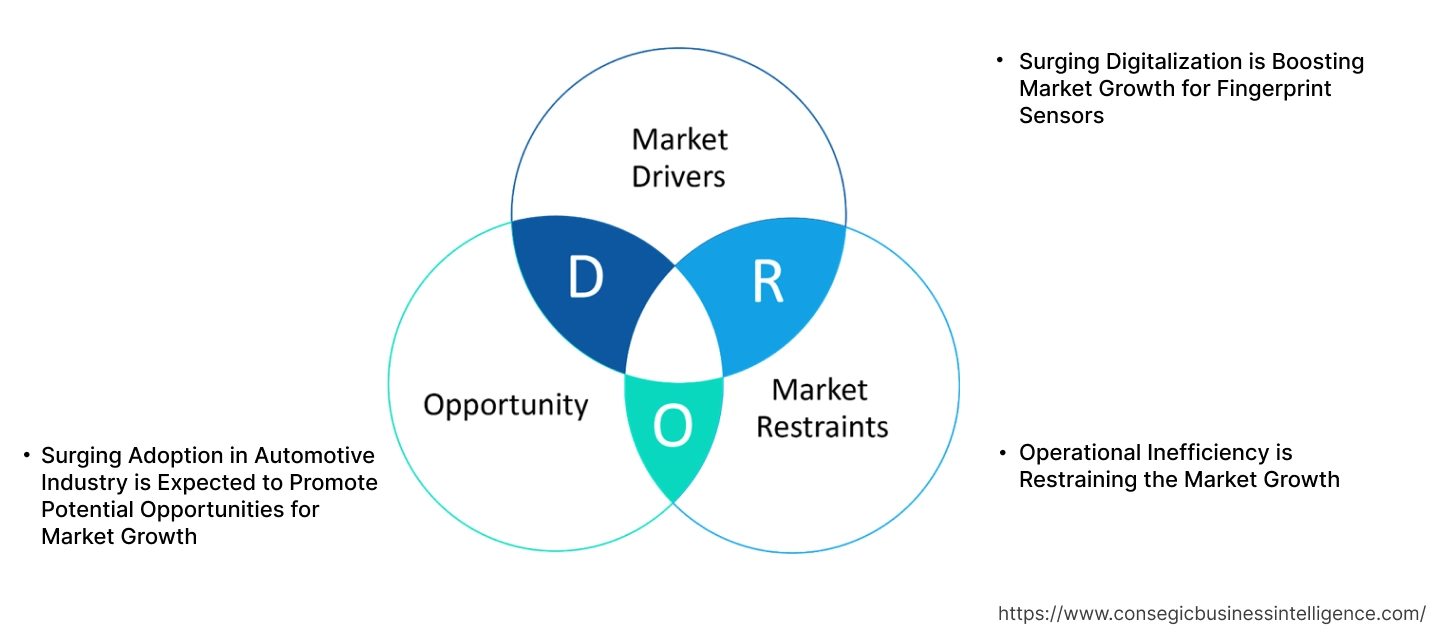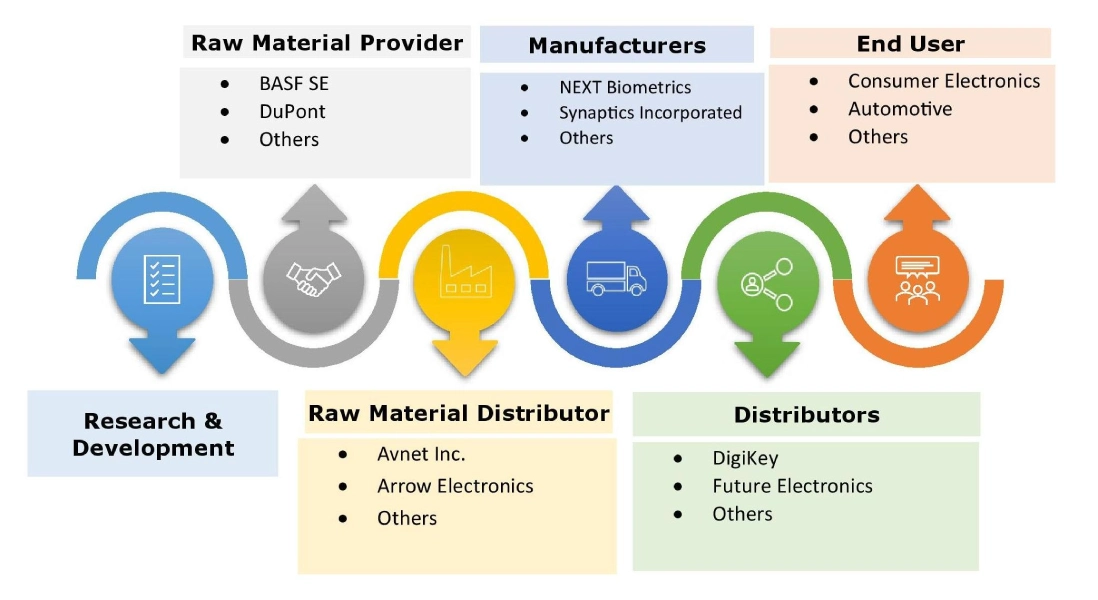Fingerprint Sensor Market Size:
Fingerprint Sensor Market size is estimated to reach over USD 16.73 Billion by 2032 from a value of USD 5.70 Billion in 2024 and is projected to grow by USD 6.42 Billion in 2025, growing at a CAGR of 12.71% from 2025 to 2032.
Fingerprint Sensor Market Scope & Overview:
The fingerprint sensor is a device utilized to verify a person's identity for access to devices or systems. Also, the device is mainly found in smartphones, laptops, and other devices, as well as in security systems and time attendance systems. Additionally, the key benefits include security, convenience, reliability, and cost-effectiveness, among others are fueling the fingerprint sensor market growth. Further, the rising adoption of devices in smartphones, automotive, and healthcare is boosting the fingerprint sensor market demand. Further, the device provides long-term, reliable performance, reducing the need for frequent replacements or upgrades, in turn fueling the fingerprint sensor industry.
How is AI Transforming the Fingerprint Sensor Market?
AI is significantly impacting the fingerprint sensor market by enhancing accuracy, speed, and security. Through machine learning, fingerprint sensors can better recognize partial, distorted, or aged fingerprints, reducing false rejections and improving user experience. AI also enables advanced spoof detection, helping distinguish between real fingerprints and fake ones made from materials like silicone or gel. In addition, AI supports adaptive learning, allowing the sensor to improve performance over time based on usage patterns. This makes fingerprint authentication more reliable in various environmental conditions, such as moisture or dirt. As a result, AI is helping expand the use of fingerprint sensors across mobile devices, automotive systems, and secure access control.
Fingerprint Sensor Market Dynamics - (DRO) :
Key Drivers:
Surging Digitalization is Boosting Market Growth for Fingerprint Sensors
The increasing demand for secure authentication methods across various sectors, including consumer electronics, financial services, and government sectors, is driving the fingerprint sensor market growth. Also, the shift towards digital payments and online transactions, due to a secure and convenient way to authenticate users on mobile devices, is driving the fingerprint sensor market demand. Further, the government initiatives promoting digital identification are fueling the market adoption.
- For instance, in July 2024, according to PIB India, the MoPNG issued directions to oil marketing companies on biometric Aadhaar-based authentication for direct benefit transfer (DBT) schemes of LPG consumers.
Therefore, the shift towards digital payments and online transactions is driving the demand for devices, in turn, proliferating the growth of the market.
Key Restraints:
Operational Inefficiency is Restraining the Market Growth
The sensors are sensitive to environmental conditions such as dryness, moisture, dirt, or skin conditions, which in turn are hindering the fingerprint sensor market expansion. Additionally, the technology is susceptible to damage or contamination, while capacitive sensors can be affected by static electricity which in turn is restraining the market adoption. Further, extreme temperatures, humidity, and other environmental conditions impact sensor performance thereby creating a barrier for market adoption in various sectors.
Therefore, the operational inefficiency is hindering the fingerprint sensor market expansion.
Future Opportunities :
Surging Adoption in Automotive Industry is Expected to Promote Potential Opportunities for Market Growth
The sensors offer a more secure alternative to traditional key fobs or passwords, making it harder for unauthorized individuals to access or start a vehicle, and are paving the way for fingerprint sensor market opportunities. Additionally, the sensors have the ability to store preference data, which is utilized to quickly access their preferred settings for the driver's seat, mirrors, climate control, and infotainment system, which in turn is driving the market adoption in the automotive sector.
- For instance, in October 2024, Infineon Technologies AG launched CYFP10020A00 and CYFP10020S00, which are automotive-qualified fingerprint sensor ICs. The sensor has the ability to provide in-vehicle personalization and payment authentication, among others.
Hence, the rising adoption in the automotive industry is anticipated to increase the utilization of devices, in turn promoting prospects for fingerprint sensor market opportunities during the forecast period.
Fingerprint Sensor Market Segmental Analysis :
By Type:
Based on the type, the market is bifurcated into area/touch sensor and swipe sensor.
Trends in the Type:
- The increasing adoption of under-display fingerprint sensors is driving the adoption of Area/Touch sensors, in turn fueling the fingerprint sensor market trends.
- The ongoing advancements in sensor technology for improving accuracy, speed, and reliability are driving the adoption of swipe sensors, which in turn fuels the fingerprint sensor market trends.
Area/Touch Sensor accounted for the largest revenue share in the year 2024 and is anticipated to register the fastest CAGR during the forecast period.
- The increased demand for secure biometric authentication in devices such as smartphones and IoT devices is driving the adoption of Area/Touch sensors, which in turn fuels the fingerprint sensor market size.
- Additionally, the sensors are gaining popularity for their accuracy and speed by capturing high-resolution fingerprint images through touch is boosting the fingerprint sensor market share.
- Further, the rising adoption in healthcare organizations for patient identification and data security, accurate record-keeping, and preventing medical identity theft is driving the fingerprint sensor market share.
- For instance, in March 2021, Synaptics partnered with Lenovofor the deployment of ultra-slim fingerprint sensors for the ThinkPad notebook. The new power-on touch fingerprint reader button enables convenient biometric authentication and wake-up with one touch of a finger.
- Thus, according to the fingerprint sensor market analysis, the increased demand for secure biometric authentication in devices such as smartphones and IoT devices is driving the market progress.
By Technology:
Based on the technology, the market is segmented into optical, capacitive, ultrasonic, and thermal.
Trends in the Technology:
- The trend towards the increasing use of biometric authentication in various applications, including mobile payments and enterprise security, is driving the adoption of capacitive sensors.
- The trend towards creating smaller and thinner ultrasonic sensors allows for their integration into compact devices is boosting the market progress.
Capacitive accounted for the largest revenue share of 49.24% in the year 2024.
- The rise of under-display sensors and ongoing advancements in sensor speed, accuracy, and resistance to environmental factors are driving the adoption of capacitive sensors, which in turn fuels the fingerprint sensor market size.
- Additionally, the capacitive sensors are being integrated into a wider range of devices, including IoT devices and wearable electronics, paving the way for market adoption.
- Moreover, the key advantages of capacitive sensors, including accuracy, speed, cost-effectiveness, and form factor among others, are driving the market progress.
- Further, the capacitive sensors offer a good balance of performance and cost, making them suitable for a wide range of devices.
- Thus, according to the fingerprint sensor market analysis, the rising adoption in IoT devices and wearable electronics is driving the market progress.
Ultrasonic is anticipated to register the fastest CAGR during the forecast period.
- The ultrasonic sensors offer a more secure method of fingerprint authentication compared to older technologies like optical sensors.
- Additionally, consumers are increasingly relying on biometric authentication for securing devices, which in turn is leading to a greater demand for ultrasonic fingerprint recognition sensors in smartphones, laptops, and other devices.
- Further, the ongoing advancements, such as improved miniaturization, power efficiency, and accuracy, are driving the need for ultrasonic fingerprint recognition
- For instance, in May 2024, Goodix launched an ultrasonic fingerprint solution, which is integrated into vivo X100 Ultra, offering a seamless and secure unlocking experience for mobile devices.
- Therefore, as per the market analysis, the ongoing advancements are anticipated to boost the market during the forecast period.
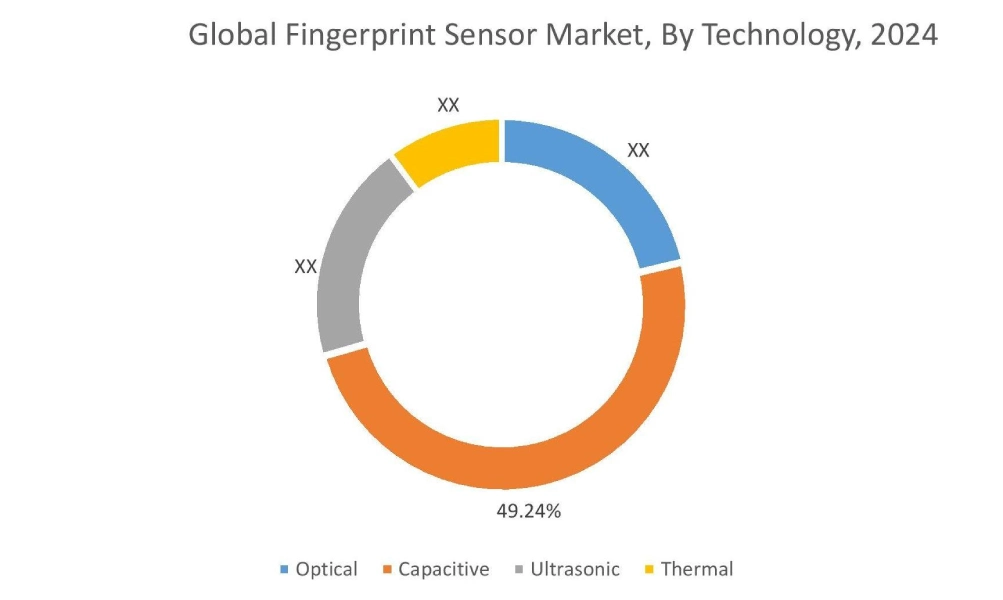
By End User:
Based on the end user, the market is segmented into consumer electronics, healthcare, BFSI, automotive, government, military & defence, and others.
Trends in the End User:
- The trend towards the proliferation of foldable displays is propelling the need for under-display fingerprintrecognition sensors, which in turn is fueling the market progress.
- The trend towards the integration of fingerprint recognition systems with robust multi-factor authenticationsystems is driving the market evolution in the BFSI sector.
Consumer Electronics accounted for the largest revenue share in the year 2024.
- The increasing need for enhanced security and convenience is driving the need for sensors. Also, stringent data privacy regulations are pushing the development of more secure and reliable fingerprint technologies.
- Additionally, the proliferation of smartphones, wearables, and IoT devices is driving the need for fingerprint recognition for user authentication.
- Further, the AI is integrated into sensors to enhance the accuracy and speed of fingerprint recognition systems, which in turn is paving the way for adoption in smart home devices, wearables, and automotive applications for driver authentication and keyless entry.
- For instance, according to IBEF, the number of smartphone shipments from India reached 35.3 million units, showing an increase of 8% YoY in Q1FY24, which in turn is paving the way for market progress.
- Thus, as per the market analysis, AI integration with sensors is driving the market progress.
BFSI is anticipated to register the fastest CAGR during the forecast period.
- The rise of digital fraud and the need for regulatory compliance are driving the adoption of fingerprint recognition sensors for identity verification in the BFSI sector.
- Additionally, the key factors driving the market adoption in the BFSI sector are the integration into ATMs, mobile banking apps, and fintech platforms to improve security and streamline user experience.
- Further, the fingerprint recognition sensors offer a more convenient and faster authentication method compared to traditional passwords, enhancing user satisfaction with online and mobile banking services.
- Therefore, as per the market analysis, the aforementioned factors are anticipated to boost the market during the forecast period.
Regional Analysis:
The regions covered are North America, Europe, Asia Pacific, Middle East and Africa, and Latin America.
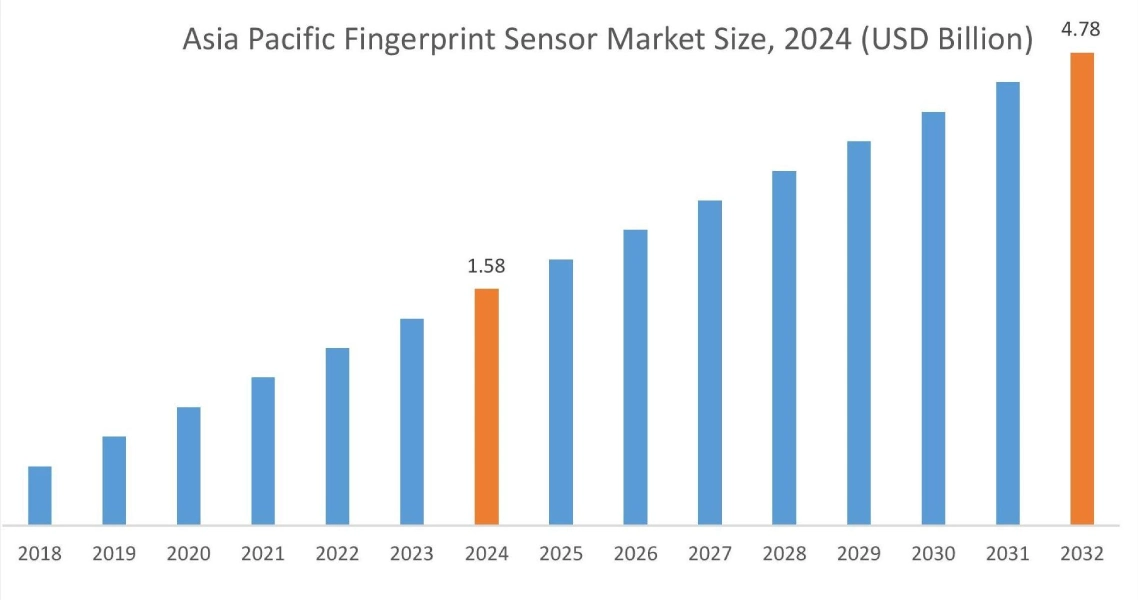
Asia Pacific region was valued at USD 1.58 Billion in 2024. Moreover, it is projected to grow by USD 1.79 Billion in 2025 and reach over USD 4.78 Billion by 2032. Out of this, China accounted for the maximum revenue share of 32.84%. The market progress is mainly driven by rising government initiatives to promote digitalization. Furthermore, factors including the rise of in-display fingerprint recognition sensors and the expansion into new applications such as automotive and smart homes are projected to drive the market growth in the Asia Pacific region during the forecast period.
- For instance, in May 2024, Fingerprint Cards AB partnered with Lapa Electric for the integration of biometric authentication into e-scooters, aiming to create India’s first biometric-enabled electric scooter.
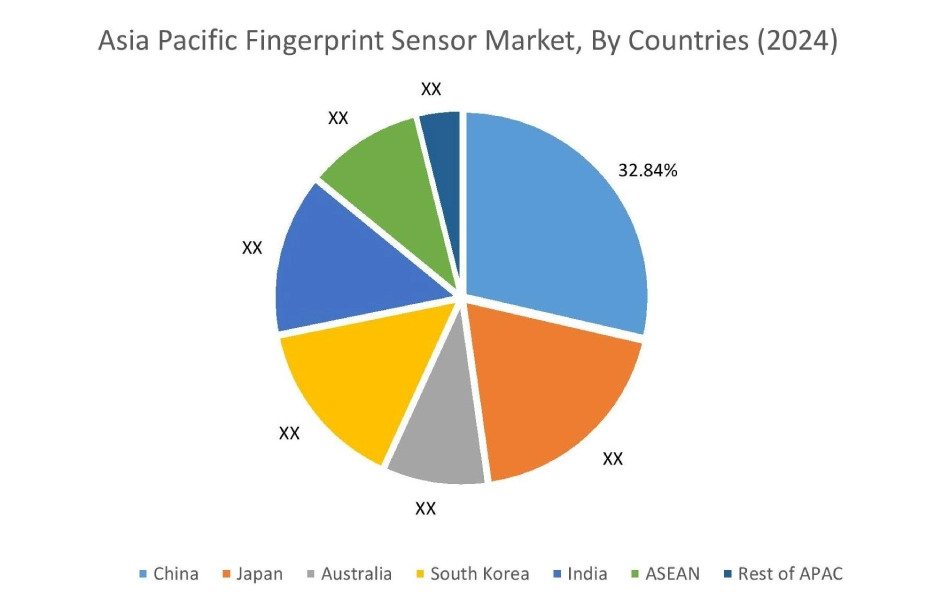
North America is estimated to reach over USD 5.45 Billion by 2032 from a value of USD 1.84 Billion in 2024 and is projected to grow by USD 2.08 Billion in 2025. The North American region's growing focus on developing fingerprint recognition sensors using eco-friendly materials and energy-efficient designs offers lucrative growth prospects for the market. Additionally, the increasing incorporation of AI and machine learning algorithms is driving the market's progress.
- For instance, in May 2022, SecuGen launched the Hamster Pro 30 fingerprint reader and U30 OEM sensoroffering of high-quality, rugged, affordable fingerprint recognition sensors and readers for application in healthcare, retail, finance, and others.
The regional analysis depicts that the rising adoption of biometric authentication in smartphones, banking, and government applications is driving the market in Europe. Additionally, the key factor driving the market is the government initiatives promoting digital transformation, as well as a rising awareness of security solutions is propelling the market adoption in the Middle East and African region. Further, the integration of AI for improved functionality and a rising adoption in the BFSI sector is paving the way for the progress of the market in the Latin American region.
Top Key Players and Market Share Insights:
The global fingerprint sensor market is highly competitive with major players providing device to the national and international markets. Key players are adopting several strategies in research and development (R&D), product innovation, and end user launches to hold a strong position in the fingerprint sensor industry. Key players in the fingerprint sensor market include-
- NEXT Biometrics(Norway)
- Shenzhen Goodix Technology Co., Ltd.(China)
- Vicharak (India)
- Invixium (Canada)
- M2SYS Technology (USA)
- Synaptics Incorporated(USA)
- Qualcomm Technologies, Inc.
- Egis Technology Inc. (Taiwan)
- Touch Biometrix (UK)
- Fingerprints (Sweden)
Recent Industry Developments :
Product launches:
- In June 2025, Token launched Token BioKey and Token BioKey Plus, aiming to provide enterprises with phishing-resistant, passwordless multifactor authentication (MFA).
- In June 2025, Adesso launched TAA-compliant peripherals integrated with fingerprint technology for application in government, healthcare, and finance sectors, in turn enabling one-touch identity verification.
Fingerprint Sensor Market Report Insights :
| Report Attributes | Report Details |
| Study Timeline | 2019-2032 |
| Market Size in 2032 | USD 16.73 Billion |
| CAGR (2025-2032) | 12.71% |
| By Type |
|
| By Technology |
|
| By End User |
|
| By Region |
|
| Key Players |
|
| North America | U.S. Canada Mexico |
| Europe | U.K. Germany France Spain Italy Russia Benelux Rest of Europe |
| APAC | China South Korea Japan India Australia ASEAN Rest of Asia-Pacific |
| Middle East and Africa | GCC Turkey South Africa Rest of MEA |
| LATAM | Brazil Argentina Chile Rest of LATAM |
| Report Coverage |
|
Key Questions Answered in the Report
How big is the fingerprint sensor market? +
The fingerprint sensor market size is estimated to reach over USD 16.73 Billion by 2032 from a value of USD 5.70 Billion in 2024 and is projected to grow by USD 6.42 Billion in 2025, growing at a CAGR of 12.71% from 2025 to 2032.
Which segmentation details are covered in the fingerprint sensor report? +
The fingerprint sensor report includes specific segmentation details for type, technology, end user, and regions.
Which is the fastest segment anticipated to impact the market growth? +
In the fingerprint sensor market, the ultrasonic sensor technology is the fastest-growing segment during the forecast period due to ongoing advancements such as improved miniaturization, power efficiency, and accuracy.
Who are the major players in the fingerprint sensor market? +
The key participants in the fingerprint sensor market are NEXT Biometrics (Norway), Shenzhen Goodix Technology Co., Ltd. (China), Synaptics Incorporated (USA), Qualcomm Technologies, Inc., Egis Technology Inc. (Taiwan), Touch Biometrix (UK), Fingerprints (Sweden), Vicharak (India), Invixium (Canada), M2SYS Technology (USA), and others.
What are the key trends in the fingerprint sensor market? +
The fingerprint sensor market is being shaped by several key trends including the proliferation of foldable displays is propelling the need for under-display fingerprint sensors, as well as the trend towards creating smaller and thinner ultrasonic sensors, allowing for their integration into compact devices, and others.
